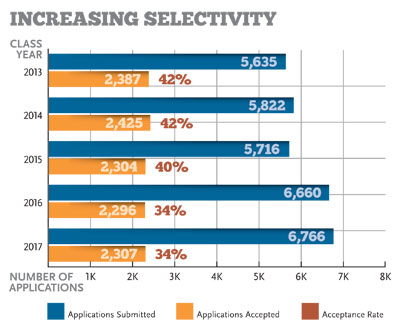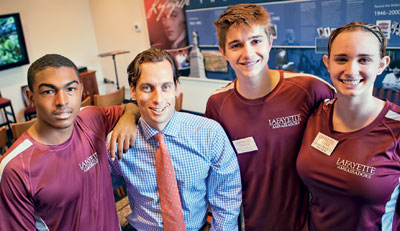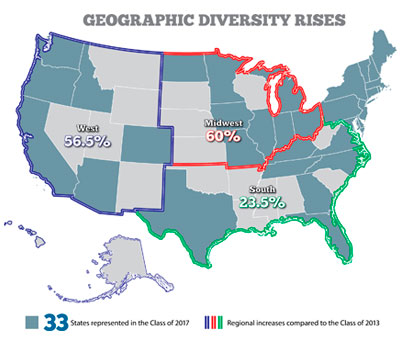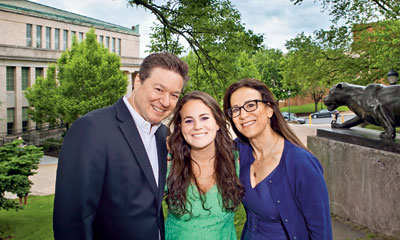The Class that Lafayette Built

Mark Mulligan ’16 (L-R), Malahat Mazaher ’16, and Kevin Lugo ’16 are among the more than 150 student ambassadors who lead campus tours for prospective students.
by Lori H. Burke | illustration by Kristen Oritz
At a time of increasingly hot competition in the college and university marketplace, more high-caliber students from around the world are interested in what Lafayette has to offer. For the second straight year, the College experienced a record-breaking applicant pool as other notable colleges saw declines.
 While this success certainly reflects the desirability of Lafayette’s distinctive education, it also demonstrates that the College is bringing its brand to the marketplace in a compelling way. Today, classes are built through a recruiting effort that marries the best of old and new admissions strategies with an undeniable Lafayette flair. The effort is aided by an army of Leopard alumni who know from personal experience the value of launching your life on the Hill.
While this success certainly reflects the desirability of Lafayette’s distinctive education, it also demonstrates that the College is bringing its brand to the marketplace in a compelling way. Today, classes are built through a recruiting effort that marries the best of old and new admissions strategies with an undeniable Lafayette flair. The effort is aided by an army of Leopard alumni who know from personal experience the value of launching your life on the Hill.
Since peaking in 2008-09, the number of high school graduates has been on the decline in the Northeast. As the number of prospective students has decreased, their educational options have increased. In addition, economic considerations about college costs, which can vary by nearly $20,000 per year between a small private college and a large public university, have had an impact. As a result, some traditionally selective private colleges are feeling the pinch of diminishing applications.
Greg MacDonald, dean of admissions and financial aid, says Lafayette was not immune to the negative trend. “We saw a declining applicant pool from 2009 to 2011 at a time when other schools were increasing theirs,” he says. “And our dependency on Pennsylvania, New York, and New Jersey was growing.”
MacDonald, who was hired in July 2010 to lead the College’s recruiting effort, and the admissions and communications teams launched initiatives that have created significant demand. Lafayette received 6,660 applications for places in the Class of 2016, a record-setting applicant pool and a remarkable 16.5 percent increase from the prior year. This year, the admissions team topped that, bringing in 6,766 applications for the Class of 2017.

Matt Hyde (center), director of admissions, with Randall Logan ’14 (L-R), Kevin Robinson ’16, and Candace Beach ’15, three of the many student ambassadors who lead campus tours.
“We have effectively lowered our acceptance rate from 41 percent two years ago to around 34 percent this year,” explains MacDonald. “Our growth has resulted from more applications from the most-qualified students. And we’ve been enrolling a higher number of those top-rated students. It’s certainly an exciting time to be at Lafayette.”
A major catalyst in this paradigm shift has been Matt Hyde, hired as director of admissions two years ago. MacDonald says Hyde’s energy, optimism, and enthusiasm have been key to the success.
“I was drawn to Lafayette as an institution poised,” says Hyde. “It was apparent through my explorations of Lafayette as a candidate that the College is and always has been a powerful institution, but that it had been relatively quiet about celebrating its presence beyond its backyard. With considerable resources and a great story to tell, I was compelled to join the team, help energize the message, and share it on a broader scale.”
GROWING DISTINCTION
“Lafayette’s high-quality education is where it all starts,” MacDonald says. “Our success is really a reflection of what the faculty are doing in the classroom and our ability to tell that story in a compelling way to prospective students.”
Wendy Hill, provost and dean of the faculty, says Lafayette has been aggressive in efforts to distinguish itself from its competitors. “From our 2007 strategic plan, we have put forward a number of initiatives that are really focused on enhancing the connections that we make across the four divisions of the College,” she explains. “With the breadth of a curriculum that includes engineering, we make interesting connections that other colleges cannot.”
Notable among recent initiatives is the Center for Innovation, Design, Entrepreneurship, and Leadership, known as IDEAL.
IDEAL will give students the opportunity to connect arts, sciences, and engineering principles to real-world issues, to acquire practical skills for the business world, to develop global and multicultural perspectives, and to deepen collaborative leadership skills. Edward Gamber, David M. ’70 and Linda Roth Professor of Economics, and John Nestor, professor of electrical and computer engineering, were named Robert W. Adenbaum ’49 Co-Chairs of the center, a title that reflects the support of the late Robert W. Adenbaum ’49.
“IDEAL’s platform for multidisciplinary projects and collaborations will help students explore complex problems,” Hill explains. “Through the center, students in all divisions of the College will learn and apply skills, perspectives, and attributes of creative leaders in the business, nonprofit, and government sectors.” The first program, Business LINK, will be launched in January. It will help students learn more about the world of global business and connect that with their particular major and practice.
Global education and the arts are two other areas that have been strengthened and enhanced, making Lafayette more relevant and competitive in preparing students for their careers and their lives.
 Recent curricular enhancements have included the significant recasting of the International Affairs major and the addition of a major in Asian Studies. Additional teaching power has been gained through the hiring of faculty who focus on global topics, and a director of international and off-campus education oversees a steadily expanding study-abroad program. In addition, the College will soon construct the Oechsle Center for Global Education, which will be the academic and administrative heart of global studies and serve as a model for interdisciplinary inquiry and a magnet for students eager to become global citizens.
Recent curricular enhancements have included the significant recasting of the International Affairs major and the addition of a major in Asian Studies. Additional teaching power has been gained through the hiring of faculty who focus on global topics, and a director of international and off-campus education oversees a steadily expanding study-abroad program. In addition, the College will soon construct the Oechsle Center for Global Education, which will be the academic and administrative heart of global studies and serve as a model for interdisciplinary inquiry and a magnet for students eager to become global citizens.
 It will house the International Affairs program and the anthropology and sociology department and will be a key center of activity for area studies programs, including Africana Studies.
It will house the International Affairs program and the anthropology and sociology department and will be a key center of activity for area studies programs, including Africana Studies.
“Our global education initiative reaches out across all the divisions of the College,” says Hill. “This initiative reflects our commitment to meet the needs of our students and graduates in a complex, rapidly changing world.”
In addition to launching majors in film & media studies and theater, the College is renovating a historic building and constructing new ones to create the Williams Arts Campus adjacent to the Williams Visual Arts Building. The buildings will include a black box theater, a costume and scene shop, a film-screening facility, screening room, classroom space, and offices.
A 2011 grant from the Mellon Foundation is supporting efforts to integrate the visual and performing arts more fully into students’ lives through the creation of new academic and extracurricular programs, the enhancement of existing offerings, and the forging of stronger ties between the College and other artists and arts communities.
The grant also supports the creation a new faculty-level position, director of the arts, who will facilitate the infusion of the arts throughout the curriculum. Hill announced that Suzanne Westfall, professor of English and theater, will serve a two-year term as interim director.
21ST-CENTURY RECRUITMENT
As the academic programs advance, the admissions team is refining its efforts. “Recently, we’ve had laser-like focus on our operations and research side, and it’s allowed us to be much more strategic in our decision-making,” says MacDonald. That key effort is led by Carol Rowlands ’81, associate dean of admissions and financial aid.
Most of the admissions advances, though, are the result of combining what has worked well in the past with today’s analytical and electronic communications tools.
“Our new recruitment strategies blend targeted emails with print publications and social media,” says MacDonald, “but without old-fashioned, face-to-face recruitment, we cannot be successful. We’re simply talking to more people than we had been. We’re visiting markets that we had gotten away from, and visiting markets multiple times in a recruitment season. We’ve gone from roughly 700 high school visits a year to almost 1,200.” This expansion includes visiting 39 states and 22 countries compared to 22 and 11 four years ago. During the past two years, visits were made to Alabama, Idaho, Kansas, Kentucky, Louisiana, Oklahoma, Tennessee, Utah, Vermont, and West Virginia, all locations that Lafayette had not previously visited.
 “We’re paying more attention to New England, the Washington, D.C. area, Atlanta, the West Coast and the Chicago area, as well as visiting Houston and Dallas much more than in the past,” he says.
“We’re paying more attention to New England, the Washington, D.C. area, Atlanta, the West Coast and the Chicago area, as well as visiting Houston and Dallas much more than in the past,” he says.
A recruitment strategy founded on building relationships makes sense for Lafayette.
“For generations, the education here has been known to be hands-on and highly personalized. Our admissions and financial aid process reflects that,” says MacDonald. “That’s what I’m most proud of—that we’re growing our applicant pool organically, through high-touch efforts.”
Hyde adds that promoting the College in new markets and spending more time in existing primary ones has built new relationships and excited existing relationships with high schools and counselors. “The admissions team is strong, and shepherding these connections has helped build our applicant pool.”
This personalized approach includes a renewed emphasis on the admission interview and an enhanced campus-tour program.
“We strongly encourage prospective students to have an admissions interview, especially as we’re getting more selective. We want to hear in their own words why they think they’d be a good fit for Lafayette,” MacDonald says. “Ultimately, the interview is going to help us make better admissions decisions and will build relationships that positively influence prospective students’ enrollment choices.”
In addition, campus tours have been made more effective by selecting student guides through a competitive process, training them, and reducing the size of tour groups. “Our goal is not to have more than three families with a tour guide,” says MacDonald. “On some days, I’m thrilled when I see one tour guide per family. That makes a huge difference.”
MOMENTUM AND DIVERSITY
“Education here is highly personalized. Our admissions and financial aid process reflects that…we’re growing our applicant pool through high-touch efforts.”
— GREG MACDONALD
Last summer, Lafayette created a new position—West Coast regional director of admissions—and tapped Ed Devine, a seasoned pro, to fill it. With more than two decades of experience in college admissions, Devine has successfully created regionally based recruitment offices for other colleges and universities.
Based in San Diego, Devine’s efforts are paying dividends. “Lafayette is respected, but a little under-recognized on the West Coast,” he says. “This year, we saw about a 10 percent increase in the western applicant pool—Alaska, California, Hawaii, Oregon, and Washington—and expect to double our applications by the third year. But it’s not just about increasing the number of applications. We’re really looking to find the right students. Quality students, certainly. But also students who are going to be a good fit at Lafayette. To do that, it’s going to require building momentum.”
The momentum that Devine hopes to create would be impossible without the aid of alumni like Marie Garofalo ’10 of Glendale, Calif. After graduating with a degree in English and policy studies, she moved to California to accept her current position as communications coordinator for Disney Consumer Products. She volunteers as an Alumni Admissions Representative (AAR) and was recognized as the New AAR of the Year in 2011.
Garofalo knows how emotional the college choice can be. “It’s a huge decision. When I was a prospective student, I could only hear ‘the brochure’—the typical speech about the college—from some admissions officers,” she recalls. “When you’re considering where you’re going to be every day for four years, you want to talk to people who understand the culture. Ultimately, I really valued speaking with current students or people who were fresh out of the college.”
 In addition to attending receptions for accepted students, Garofalo also is participating in alumni group interviewing events that the admissions team has launched across the country. “In November, a couple of other alumni, a parent of a current student, and I participated in a panel discussion and answered questions from prospective students and their parents at a special event in Pasadena. Then we interviewed each student individually,” Garofalo says.
In addition to attending receptions for accepted students, Garofalo also is participating in alumni group interviewing events that the admissions team has launched across the country. “In November, a couple of other alumni, a parent of a current student, and I participated in a panel discussion and answered questions from prospective students and their parents at a special event in Pasadena. Then we interviewed each student individually,” Garofalo says.
About 400 alumni around the world support their alma mater as AARs. They are not only increasing the applicant pool for Lafayette but are helping bring diversity of thought to the College’s classrooms.
In the Boston area, Robert Wolff ’70 of Chestnut Hill, Mass., is interviewing prospective students. As associate professor of biology and director of the pre-medical program at Boston College, Wolff knows the value of diverse thinking in the classroom.
“Students from different geographic and socio-economic backgrounds often will bring different perspectives. It enlivens the discussion,” says Wolff, an anthropology and sociology graduate who earned his doctorate in biology at Tufts University.
Wolff volunteers as an AAR to support an alma mater he loves and help young men and women at a pivotal point in their lives. “In many ways I view admissions interviews as counseling sessions. I try to find out what the students’ interests are, what their values are, and what type of school they might be looking at. Then, I help them take that information and make decisions,” says Wolff.
ADVANCING ALUMNI INVOLVEMENT
Hyde also believes AARs have a greater impact than just recruiting. “We do want our alumni to be a face and a voice for Lafayette, no doubt. But at the same time, we also want them to recognize that they have a moment to affect and impact young men and women in their backyards and excite and inspire them about college and Lafayette’s version of that experience.”

In May, Lisa Kassel ’79 and husband Mitchell Winter ’79 returned to the Hill to celebrate as one of their Lafayette recruits received her diploma —their daughter, Rebecca Winter ’13.
Hyde and Lisa Kassel ’79, chair of the Admissions Committee of the Alumni Council, are collaborating to enlist more AARs. “We love recent graduates who have stepped off the Hill and launched into the world to be proponents and advocates for Lafayette wherever they land,” says Hyde. “We also need our seasoned alumni in this mix, as they can share how powerful their Lafayette experience was and the great opportunities it elevated in their lives.”
Kassel, a fundraising consultant in New York City, reconnected with the College as an AAR about a dozen years ago. “When my kids started getting older, I began to wonder where they would go to college,” she says. “I started paying more attention to Lafayette, because it was a great school when I attended, and I’ve been so impressed with the changes over the years.” A government and law graduate, she earned a master’s in public administration from Baruch College.
“Interviewing prospective students was a great place to get involved,” Kassel says. “I love connecting with younger people. Kids are so exciting to talk to when they are embarking on this exploration. And I love seeing how a Lafayette education can help them. It is about giving back. But it also is about giving to the next generation and staying connected to something I feel strongly about.”
In May, Kassel and husband Mitchell Winter ’79 returned to the Hill to celebrate as one of their Lafayette recruits received her diploma—their daughter, Rebecca Winter ’13, a film & media studies and psychology graduate and quite possibly Lafayette’s next AAR.